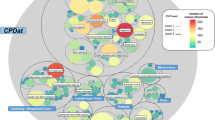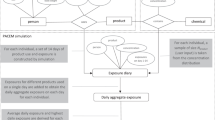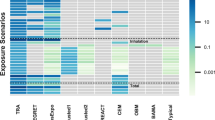Abstract
Predictive models are used to estimate exposures from consumer products to support risk management decision-making. These model predictions may be used alone in the absence of measured data or integrated with available exposure data. When different models are used, the resulting estimates of exposure and conclusions of risk may be disparate and the origin of these differences may not be obvious. This Perspectives Paper provides recommendations that could promote more systematic evaluation and a wider range of applicability of consumer product exposure models and their predictions, improve confidence in model predictions, and result in more accurate communication of consumer exposure model estimates. Key insights for the exposure science community to consider include: consistency in product descriptions, exposure routes, and scenarios; consistent and explicit definitions of exposure metrics; situation-dependent benefits from using one or multiple models; distinguishing between model algorithms and exposure factors; and corroboration of model predictions with measured data.
This is a preview of subscription content, access via your institution
Access options
Subscribe to this journal
Receive 6 print issues and online access
$259.00 per year
only $43.17 per issue
Buy this article
- Purchase on Springer Link
- Instant access to full article PDF
Prices may be subject to local taxes which are calculated during checkout
Similar content being viewed by others
References
European Center for Ecotoxicology and Toxicology of Chemicals (ECETOC) (BE). Targeted risk assessment (TRA). 2017. http://www.ecetoc.org/tools/targeted-risk-assessment-tra/. Accessed 15 Jul 2019.
Zaleski RT, Qian H, Zelenka MP, George-Ares A, Money C. European solvent industry group generic exposure scenario risk and exposure tool. J Expo Sci Environ Epidemiol. 2014;24:27–35.
European Solvents Industry Group. EGRET Version 2. 2015. https://www.esig.org/wp-content/uploads/2018/03/EGRET2MasterTemplate_Nov2015updated-4.xls. Accessed 30 Apr 2019.
National Institute for Public Health and the Environment (RIVM) (NL). ConsExpo web tool and user information. 2017. https://www.rivm.nl/en/consexpo. Accessed 15 Jul 2019.
USEPA. Consumer exposure model (CEM) version 2.0 (US) user guide. Prepared for EPA by ICF under EPA Contract #EP-W-12-010. 2017. https://www.epa.gov/sites/production/files/2017-06/documents/cem_2.0_user_guide.pdf. Accessed 30 Apr 2019.
Isaacs KK, Glen WG, Egeghy P, Goldsmith MR, Smith L, Vallero D, et al. SHEDS-HT: an integrated probabilistic exposure model for prioritizing exposures to chemicals with near-field and dietary sources. Environ Sci Technol. 2014;48:12750–9.
Stochastic Human Exposure Dose and Simulation High Throughput (SHEDS-HT), R Package. 2017. https://github.com/HumanExposure/SHEDSHTRPackage. Accessed 30 Apr 2019.
Feld-Cook E, Shome R, Zaleski R, Mohan K, Kourtev H, Bekris KE, et al. Exploring the utility of robots in exposure studies. J Expo Sci Environ Epidemiol. 2019. https://doi.org/10.1038/s41370-019-0190-x.
Kephalopoulos S, Bruinen de Bruin Y, Arvanitis A, Hakkinen P, Jantunen M. Issues in consumer exposure modeling: towards harmonization on a global scale. J Expo Sci Environ Epidemiol. 2007; Suppl 1:S90–100. Epub 2007 Aug 1.
Mokhtari A, Christopher Frey H, Zheng J. Evaluation and recommendation of sensitivity analysis methods for application to Stochastic Human Exposure and Dose Simulation models. J Expo Sci Environ Epidemiol. 2006;16:491–506. Epub 2006 Jan 25
World Health Organisation. Guidance on characterizing and communicating uncertainty in exposure assessment, draft. International Programme on Chemical Safety. Geneva, Switzerland: World Health Organisation; 2007.
Savic N, Gasic B, Vernez D. ART, Stoffenmanager, and TRA: a systematic comparison of exposure estimates using the TREXMO translation system. Ann Work Expo Health. 2017;62:72–87.
Ter Burg W, Bremmer HJ, van Engelen JGM. Do-It-Yourself Products Fact Sheet to assess the risks for the consumer. Report 320104007. RIVM; 2007.
USEPA. Consumer exposure model (CEM) appendices. Prepared for EPA Office of Pollution Prevention and Toxics by ICF under EPA Contract# EP‐W‐12‐010. 2017. https://www.epa.gov/sites/production/files/2017-06/documents/cem_user_guide_appendices.pdf.
Organisation for Economic Co-operation and Development (OECD) (FR). Internationally harmonized functional, product and article use categories. ENV/JM/MONO(2017)14. 2017. http://www.oecd.org/officialdocuments/publicdisplaydocumentpdf/?cote=env/jm/mono(2017)14&doclanguage=en. Accessed 15 Jul 2019.
USDA. Food and nutrient database for dietary studies. 2016. https://reedir.arsnet.usda.gov/codesearchwebapp/%28gcp3kq55ssdyc445ry2k2rus%29/coding_scheme.pdf. Accessed 20 Feb 2020.
Isaacs KK, Dionisio K, Phillips K, Bevington C, Egeghy P, Price PS. Establishing a system of consumer product use categories to support rapid modeling of human exposure. J Expo Sci Environ Epidemiol. 2020;30:171–83.
Downstream Users of Chemicals Co-Ordination Group (DUCC) and CONCAWE (US). SCEDS specific consumer exposure determinants. 2014. http://www.ducc.eu/documents/20140424-Guidance%20documents%20on%20SCEDs-Final-V1.pdf. Accessed 15 Jul 2019.
American Industrial Hygiene Association. IH SkinPerm. 2017. https://www.aiha.org/public-resources/consumer-resources/topics-of-interest/ih-apps-tools. Accessed 20 Feb 2020.
USEPA—United States Environmental Protection Agency. Wall Paint Exposure Model (WPEM) version3.2 user’s guide. 2015. https://www.epa.gov/sites/production/files/2015-05/documents/wpemman_0.pdf. Accessed 21 Feb 2020.
Singer BC, Destaillats H, Hodgson AT, Nazaroff WW. Cleaning products and air fresheners: emissions and resulting concentrations of glycol ethers and terpenoids. Indoor Air. 2006;16:179–91.
Aylward L, Vilone G, Cowan-Ellsberry C, Arnot JA, Westgate JN, O’Mahony C, et al. Exposure to selected preservatives in personal care products: case study comparison of exposure models and observational biomonitoring data. J Expo Sci Environ Epidemiol. 2020;30:28–41.
Wambaugh JF, Setzer RW, Reif DM, et al. High-throughput models for exposure-based chemical prioritization in the ExpoCast project. Environ Sci Technol. 2013;47:8479–88.
Ring CL, Arnot JA, Bennett DH, Egeghy PP, Fantke P, Huang L, et al. Consensus modeling of median chemical intake for the U.S. population based on predictions of exposure pathways. Environ Sci Technol. 2019;53:719–32.
Li L, Westgate JN, Hughes L, Zhang X, Givehchi B, Toose L, et al. A model for risk-based screening and prioritization of human exposure to chemicals from near-field sources. Environ Sci Technol. 2018;52:14235–44.
HBM4EU program. Report on the optimal methodology for exposure reconstruction from HBM data. 2017. https://www.hbm4eu.eu/wp-content/uploads/2017/03/HBM4EU_D12.2_Optimal_methodology_for_exposure_reconstruction_v1.0.pdf. Accessed 22 Feb 2020.
Center for Time Use Research. Multinational time use study. 2016 https://www.timeuse.org/mtus. Accessed 14 May 2019.
United Nations Economic Commisson for Europe Task Force on Time Use Surveys. Guidelines for harmonising time use surveys (Draft). 2013. https://www.unece.org/fileadmin/DAM/stats/documents/ece/ces/bur/2013/12-Add.1_TimeUseSurvey_Guidelines_UNECE.pdf. Accessed 14 May 2019.
Teeguarden JG, Tan YM, Edwards SW, Leonard JA, Anderson KA, Corley RA, et al. Completing the link between exposure science and toxicology for improved environmental health decision making: the aggregate exposure pathway framework. Environ Sci Technol. 2016;50:4579–86.
Acknowledgements
Special acknowledgement is made for assistance with models to Charles Bevington, currently at the US Consumer Product Safety Council but previously at US EPA’s Office of Pollution Prevention and Toxics and Kristen Isaacs of US EPA’s National Exposure Research Laboratory. The authors are indebted to many peers who commented on the model comparisons and our observations, including members of the American Chemistry Council’s Exposure Assessment Working Group. Financial support to some authors was provided by the American Chemistry Council.
Funding
Funding to some authors is provided by the American Chemistry Council.
Author information
Authors and Affiliations
Corresponding author
Ethics declarations
Conflict of interest
The authors, HQ and RTZ, are currently or were previously employed by ExxonMobil Biomedical Sciences, Inc., a separately incorporated but wholly owned affiliate of Exxon Mobil Corporation. The other authors declare that they have no conflict of interest.
Additional information
Publisher’s note Springer Nature remains neutral with regard to jurisdictional claims in published maps and institutional affiliations.
Rights and permissions
About this article
Cite this article
Cowan-Ellsberry, C., Zaleski, R.T., Qian, H. et al. Perspectives on advancing consumer product exposure models. J Expo Sci Environ Epidemiol 30, 856–865 (2020). https://doi.org/10.1038/s41370-020-0237-z
Received:
Revised:
Accepted:
Published:
Issue Date:
DOI: https://doi.org/10.1038/s41370-020-0237-z
Keywords
This article is cited by
-
An assessment of the ECETOC TRA Consumer tool performance as a screening level tool
Journal of Exposure Science & Environmental Epidemiology (2023)



